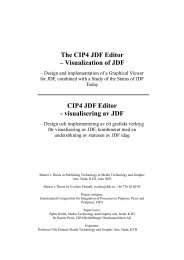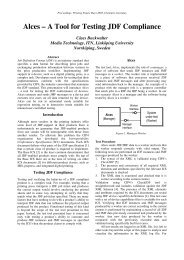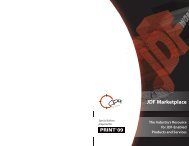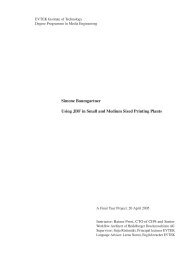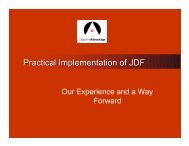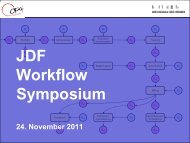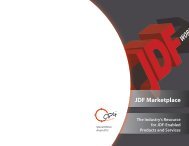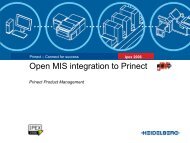The JDF Marketplace - CIP4
The JDF Marketplace - CIP4
The JDF Marketplace - CIP4
- TAGS
- marketplace
- www.cip4.org
Create successful ePaper yourself
Turn your PDF publications into a flip-book with our unique Google optimized e-Paper software.
additional data typing, defining how jobs files are to be<br />
exchanged or identified, and required support for particular <strong>JDF</strong><br />
processes and resources. It’s important to note that ICS<br />
documents do not add to the <strong>JDF</strong> specification, but rather, they<br />
provide additional constrains and a subset of <strong>JDF</strong> specific to<br />
the interface that they define.<br />
More ICS documents are in development and ICS documents<br />
will be used as the basis for certification testing. <strong>CIP4</strong> has<br />
signed on GATF as the first certification testing facility and<br />
others will be added in Europe and Asia. You will start seeing<br />
products labeled as “<strong>JDF</strong> Certified” and each certification test<br />
will be to a specific ICS document.<br />
<strong>The</strong> Four Main Functions of <strong>JDF</strong><br />
<strong>JDF</strong> has four main functions. First, it provides a single common<br />
language that supports the lifecycle of a print job. This is what<br />
people mean when they refer to <strong>JDF</strong> as a “Job Ticket”<br />
language, but it is much more than that. <strong>The</strong> second function is<br />
to provide a command and control language for devices on the<br />
shop floor. This aspect of <strong>JDF</strong> is call the Job Messaging Format<br />
or “JMF” and many folks talk about JMF almost as if it is a<br />
separate specification, but it is integral to <strong>JDF</strong>. JMF allows the<br />
controlling workflow or MIS system in a process automated<br />
environment to tell a device to start and stop jobs, reorder the<br />
queue, and so on. Third, there is inherent in <strong>JDF</strong> a flexible<br />
methodology for constructing workflows and providing the<br />
command, control, and configuration of plant automation and<br />
job production.<br />
<strong>The</strong> fourth main function was added to <strong>JDF</strong> 1.2 and that is<br />
automating the handshake, which is accomplished with device<br />
capabilities functionality. For instance, in <strong>JDF</strong> there are five<br />
staple folds that a stitcher may use. If a new stitcher is added to<br />
your <strong>JDF</strong> workflow, the governing workflow or MIS system must<br />
know which of those five folds the new stitcher supports.<br />
Communicating the set of <strong>JDF</strong> elements and attributes<br />
supported by a device to the MIS system or workflow system is<br />
creating the “handshake.”<br />
<strong>JDF</strong> Staple Folds<br />
Device capabilities allow <strong>JDF</strong> 1.2 capable devices to be<br />
automatically queried for the details of what aspects of <strong>JDF</strong><br />
they can and cannot manage. This is an important step towards<br />
total “plug-n-play” interoperability.<br />
June, 2005 <strong>JDF</strong> <strong>Marketplace</strong> Page 14





